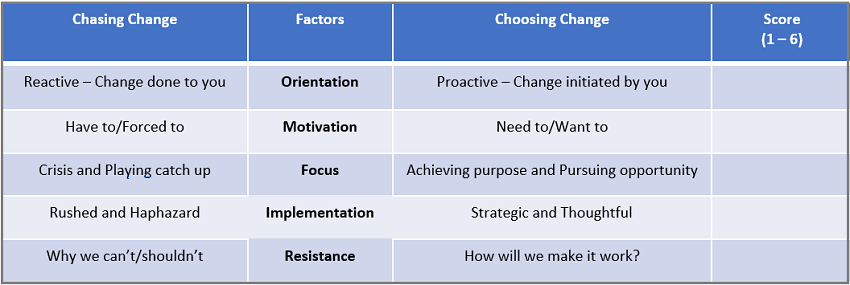The year was 1997. Office desktops were made by either IBM, Dell, or HP, and were running (hopefully) the Windows 95 operating system. The Apple iMac would not appear until the following year. IBM’s Deep Blue supercomputer defeated the reigning world chess champion Garry Kasparov.
It might not have felt like it as you peered at your 640 x 480 resolution CRT monitor while surfing the information superhighway over your Netscape Navigator browser at a blazing 28.8 kbps, but digital transformation was underway.
That same year, GE CEO Jack Welch made this comment: “The difference between winning and losing is how the men and women of our company view change as it comes at them.”
Pursuing Change
To me, the interpretation of Welch’s quote was clear: Change is coming – get ready for it. He is also quoted as saying, “Change before you have to.”
I had heard a similar message before. Twelve years earlier my wife had spoken the following words when we were married: “Randy, I’ll never ask you to change. I do expect that you will continually adapt.”
My wife and Welch were both correct. Viewing change as something to anticipate and then pursue is crucial. The challenge is that the speed and lack of predictability at which change comes at us makes planning for the future difficult. I have seen many of your To-Do lists. They are packed with urgent and immediate priorities that merely allow you to keep up.
I wrote a CIO.com article about this in the pre-pandemic world of 2019. The idea is that low predictability/high speed environments require a different type of change leadership.
We now look back at 2019 as the “good ol’ days,” and every indication is that this will be the case when we look back on 2022 through the lens of the future.
The next way to apply Welch’s quote is to realize that adapting, anticipating, and pursuing change aren’t the only choices. Ignoring, resisting, or even fleeing change are also options.
Warren Buffet said that the difference between successful people and really successful people is that really successful people say No to almost everything. While Buffet’s advice was originally intended as career guidance, the principle applies to organizations and teams, too.
Similarly, Steve Jobs once said that, “Deciding what not to do is as important as deciding what to do.”
|
Related article: Has Your IT Organization Become COVID-Lazy? By Randy Pennington |
Choosing Change versus Chasing Change
If I were re-writing Welch’s quote for today’s world, it would be something like this:
“The difference between winning and losing for an organization is how quickly and successfully its people recognize and choose an approach to change that enables them to flourish … and then work like crazy to ensure that happens.”
The only way to make this happen is to move from chasing change that comes at us to choosing change that equips, enables, and empowers us.
Choosing change isn’t just a catchy phrase. There is a significant difference between those who choose change and those who chase change.
Why not take a quick and simple test to understand where you are. Rate your team’s experience with each of the five factors of change in the table below. Use the following scale to make it easy.
1 – You exhibit the Chasing Change description all of the time.
2 – You exhibit the Chasing Change description most of the time.
3 – You exhibit the Chasing Change description more times than not.
4 – You exhibit the Choosing Change description more times than not
5 – You exhibit the Choosing Change description most of the time.
6 – You exhibit the Choosing Change description all of the time.

Our experience has been that even organizations who are the best at choosing change occasionally find themselves chasing a change that catches them off guard. The key is to improve your overall performance over time.
Missing Ingredients for Choosing Change
If you have seen my work over the years, you know that I have been laser focused on how to make change work. You can find my other contributions to the Heller Report here.
The work of leading change is basically the same regardless of whether you are chasing change or choosing change. There are, however, two missing—or at least lacking—ingredients that keep us in the chasing mode: 1. The failure to intentionally and quickly recognize the need to change, and 2. Not making conscious choices about the course of action to take.
Soon, I will devote an entire article to how to recognize change early and make better choices sooner. In the meantime, you should set aside regular time for you and your team to “scout the future.” Think of the scouts who rode with the wagon trains headed westward across the United States after the Civil War. Every day these individuals rode out over the horizon to find the best route to their destination. More important, they were constantly on the lookout for water (opportunity) and hostiles (threats).
Recognize. Choose. Work. This is the model for mastering the essential ingredient for winning and losing in the future—choosing change.

Written by Randy Pennington
Randy Pennington helps leaders deliver positive results in a world of accelerating change. He is a highly sought after resource for helping organizations prepare for their New Next™, and the author of several books, including Make Change Work.



